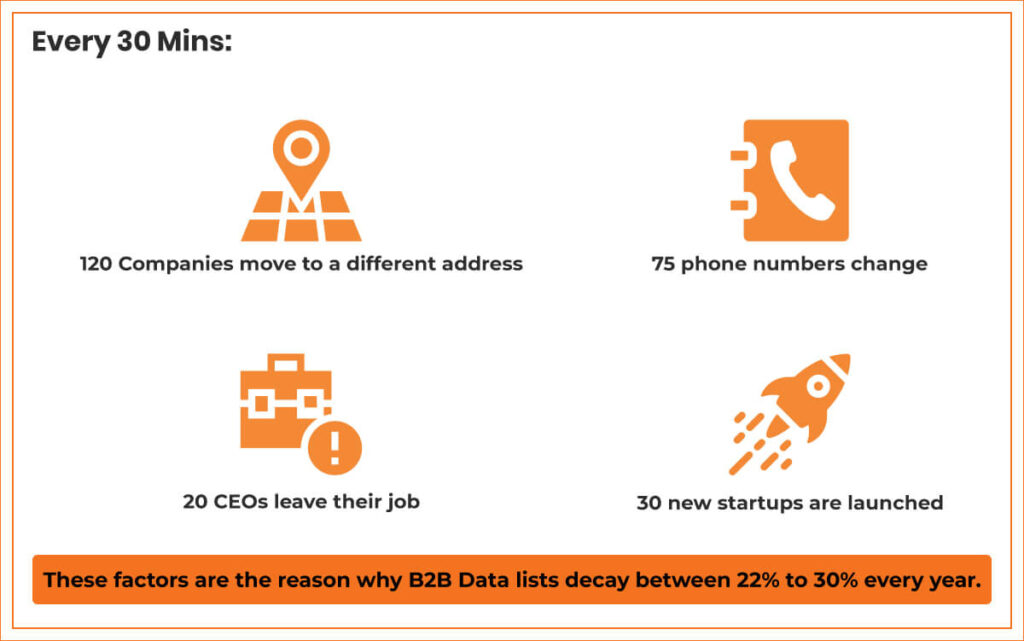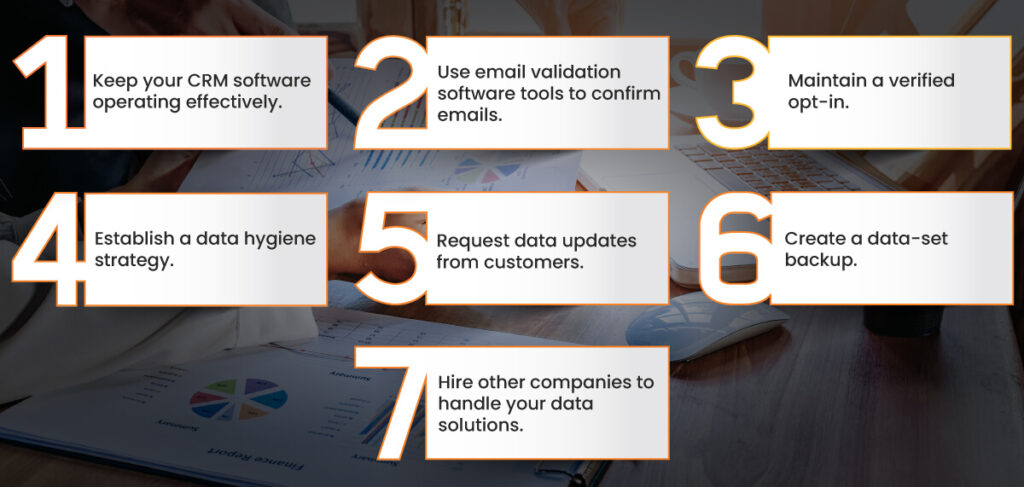
The role of data is changing along with the digital future of B2B sales. The increasing push toward digital transformation, say 72% of company leaders, has rendered organizations more dependent than ever on data when making critical business choices. In addition, 32% of respondents believe their data is erroneous, and 55% of respondents indicate they don’t trust their data assets.
Businesses-to-business (B2B) organizations must regularly update and correctly preserve data assets to stop data deterioration in order to meet the growing need for data-driven choices. However, a vast majority of firms still lack the ability to secure their data hygiene, which has a negative impact on their operations.
By squandering team resources ineffectively, losing clients and credibility, using inaccurate data might result in fewer transactions being closed and less money being made. Incorrect data alone causes B2B businesses in the United States to lose $3.1 trillion in revenue annually.
Businesses need to learn how to preserve data quality and stop rapid data decay, which is frequently the cause of many business problems, in order to securely transition to the digital era and keep up with the enormous amount of information available out there.
Must Read: Building the Best Path for B2B Sales Using the Buyer’s Journey
Data Decay: What Is It?
Table of Contents
Data decay is the process through which the accuracy of your B2B database degrades over time as a result of containing obsolete, incomplete, or inaccurate info. Unfortunately, data deterioration cannot be prevented, especially when static data is used in sales. Your data need ongoing care and maintenance in order to stay current. Your team will need to invest both time and money into this.
Why Does Data Decay Occur?
Data deterioration can happen for a number of causes, including software bugs, human error, or the inability to keep up with the flow of information that is always expanding. B2B data deteriorates on average at a monthly pace of 2.1%. A number of variables, such as the sector you work in (high-tech is especially vulnerable), the customer demographic you are aiming for, the region where you operate, etc., may have an impact on your company’s data decay rate.
Unanticipated data decay rates are caused by a variety of factors as well. Dun & Bradstreet estimates that every half hour, 120 corporate addresses, 75 phone numbers, 20 CEOs change positions, and 30 new start-ups are established. Imagine manually updating this data-point every thirty minutes during your workday. Read this insightful article about virtual prospecting and intent data.

Every 30 Mins:
120 Companies move to a different address
75 phone numbers change
20 CEOs leave their job
30 new startups are launched
These factors are the reason why B2B Data lists decay between 22% to 30% every year.
Source: Dun & Bradstreet
Numerous bits of information, such as altered names, job descriptions, phone numbers, email addresses, etc., have an impact on your database every day. The good news is that there is a lot you can do to stop data decay, despite the fact that it may seem hard to follow all the irregular changes and ensure the quality of your data.
Must Read: Sales Cadence Best Practices: Why You Should Always Dial First
How to Prevent Data Decay in B2B Sales:
Data deterioration is an ongoing process that is difficult to stop. There are ways to slow things down, though. Here are the top seven suggestions for maintaining optimized and current data:

1. Keep your CRM Software Operating Effectively.
The best source of pertinent data for creating and keeping your data-set is customer relationship management (CRM) technologies. They save your sales and marketing teams time by tracking and evaluating the sales pipeline and storing all interactions with all leads, prospects, and clients you have ever engaged. They coordinate automated email distribution as well.
CRMs are one of the best ways to maximize your data and maintain constant control over your sales activity because of all these benefits. However, make sure you abide by these three guidelines to establish a CRM system in your business successfully and prevent data decay:
Must Read: B2B Sales Dynamics: Leads, Prospects, and Opportunities
Connect your CRM System to Additional Data Solutions:
To gather as much information as possible, ensure that both marketing and sales use the same system and synchronize all the data sources in one location.
Check CRM Data:
Use firewalls to ensure the accuracy of your data and make sure it is validated as it is entered into your CRM.
Data Segmentation:
If you have numerous ideal customer profiles (ICPs), work in multiple marketplaces, or sell a variety of items, categorizing the critical data can help you improve the sales cycle and more effectively manage data quality.
Must Read: What is intent data in lead generation?
Use Email Validation Software Tools to Confirm Emails.
87% of B2B marketers use email as their primary prospecting medium for outreach. Additionally, email marketing databases age naturally by roughly 22.5% annually, which raises email bounce rates and lowers conversion rates.
In order to maintain a constant email deliverability rate, your data must be updated if your email bounce rate is high. If your emails never get to their inboxes, what use is it to have large lead lists?
Utilizing email verification software is one of the most efficient ways to solve this difficulty and purge your list of invalid and inactive email addresses. These tools make sure that the recipient’s email is authentic and that your message can be delivered securely by running a number of checks. In addition, they look into the email address, server, and domain name to avoid technical issues and spam folders.
3. Maintain a Verified Opt-In.
Implementing opt-in confirmation is another strategy for preventing email data deterioration. It is used to verify that your subscribers filled out the registration form completely and correctly entered their email address. A confirmation email will be sent to the new user after they have completed their information to complete the sign-up process with proper information.
This simple function prevents inaccurate data entry and only accepts subscribers that consciously follow your website’s news list.
4. Establish a Data Hygiene Strategy.
The most obvious strategy to maintain your database current and updated is to include regular data hygiene checks as part of a routine. This procedure entails:
- Examining current data for updates
- Deleting duplicate contacts
- Confirming fresh contacts
- Completing the gaps in the information
With the help of dynamic data solutions that can update your data-set in real-time and eliminate human checks, all these tasks may be completed automatically.
Make sure that everyone in the organization is aware of data hygiene standards, even though data hygiene inspections are typically delegated to a certain department (sales, marketing, or IT). Collaboration among the teams makes a substantial contribution to the fight against data degradation and aids in the development of a data-driven culture within the organization.
Must Read: 35 Closed-Ended Questions To Ignite Your Sales Strategy – And When to Use Them
5. Request Data Updates from Customers.
The fact that your clients’ information could occasionally change does not guarantee that they will update it. They may require a gentle push. You can ask them to update their information in the following ways:
Make use of automatic email reminders.
Some businesses decide to use automatic email reminders to customers to update or complete information. Others employ website pop-up notifications to remind users to edit their profiles.
Use interactive content to pique attention.
Another excellent technique to maintain contact with the audience is to use interesting marketing content. It assists in gathering the required information and keeps your clients up to date on company news.
Use surveys or quizzes to engage your audience.
Discuss current events to help you understand about your clients’ inclinations, wants, and aspirations in addition to fundamental knowledge. On the basis of it, you may create an efficient strategy to draw in new customers and hold onto existing ones.
Updated data will be automatically gathered and stored in your CRM. In addition, consistently delivering customers relevant and helpful content about your company can deepen client connections and facilitate conversation.
Create a data-set backup.
Hardware device malfunctions might potentially cause data deterioration. A severely degraded dataset has serious consequences: A startling 94% of businesses that experience a significant data loss never resume operations.
As you would with important files on your phone and laptop, make sure to securely store your data in the cloud to minimise the danger of lost input and to assure catastrophe recovery. The most reliable and safe method of data backup is cloud storage. Don’t forget to secure your data access and defend it against outside threats, though.
Hire other companies to handle your data solutions.
The future of B2B sales is data-driven solutions. With accurate data at their disposal, your team can enhance customer satisfaction, reduce resource consumption, and make more informed strategic decisions. However, collecting and maintaining data is not a simple task.
Be prepared to overcome all obstacles to create a high-quality data-set if you choose to employ first-party data. You can hire reputable businesses to complete this activity on your behalf if you lack the time or money to devote to building data solutions on your own. According to your company’s ICP, you can receive cutting-edge, strategic, and tailored data in a matter of minutes.
Stay Away From Data Decay in B2B Sales
Accurate databases are a critical component of B2B organization efforts to improve sales and marketing results. High-quality data may help you gain a better understanding of your present and prospective customers, giving your sales teams the information they need to generate precise lead lists, engage with prospects more effectively, and reach their target markets. Use only pertinent and up-to-date input to get the most out of your data-driven approach. If data decay is not stopped in time, it might result in severe harm. Keep in mind that it is your job to ensure that your team only uses dependable, high-quality datasets. If you are looking for someone to handle your data management, feel free to get in touch with Only B2B.

Vikas Bhatt is the Co-Founder of ONLY B2B, a premium B2B lead generation company that specializes in helping businesses achieve their growth objectives through targeted marketing & sales campaigns. With 10+ years of experience in the industry, Vikas has a deep understanding of the challenges faced by businesses today and has developed a unique approach to lead generation that has helped clients across a range of industries around the globe. As a thought leader in the B2B marketing community, ONLY B2B specializes in demand generation, content syndication, database services and more.


